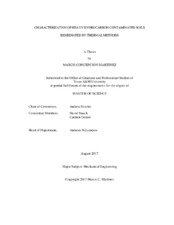| dc.description.abstract | There are numerous opportunities in the lifecycle of oil extraction, transport, and use where it can potentially contaminate the environment, in particular water and soil. Various technologies have been developed to remediate soil contamination; the techniques can be categorized as either energetic, where energy is required for treatment, or non-energetic, requiring no additional energy input. Previous studies have determined that energetic methods tend to be more effective at reducing total petroleum hydrocarbons (TPH). In particular, thermal desorption was found to remove hydrocarbons in the target molecular size range of hydrocarbon species up to C₄₀, while leaving beneficial carbon content, such as soil organics, intact. The goal of this study was the characterization of soil treated with energetic remediation methods. Specifically, soils treated by indirect thermal desorption (inert environment) or directly heated thermal desorption (heated by products of combustion, including oxygen) were characterized to determine their efficacy and investigate the underlying mechanisms. Temperature programmed reaction experiments (including oxidation and desorption) were used to measure the relative amounts of total, mobile, and fixed carbon content remaining on the treated soil. For the indirect thermal desorption, total carbon content was found to reduce proportionately with decreases in initial oil concentration and only marginally with increases in either treatment temperature or residence time. The minimum time and temperature values (15 minutes and 370°C, respectively) were found to adequately reduce total carbon and, by extension, TPH. Further increases in residence time or treatment temperature would increase treatment costs for insubstantial gains. Increased temperature and decreased oil concentration both decreased total carbon for the direct heated thermal desorption treatment. In contrast to the indirect treatment, total carbon reduction in the direct treatment appeared to be a stronger function of temperature, with total carbon content for the maximum temperature being a quarter of that at the minimum. Initial oil concentration appeared to be normalized to some extent by the direct treatment, with respective carbon content levels approaching each other. It was again determined that the minimum energy input treatments characterized herein would sufficiently reduce TPH.
For a 15 minute residence time and 420°C treatment temperature, the indirect treatment was found to have produced a larger carbon content reduction than the direct treatment. The Boudouard reaction is a proposed explanation for this result on the basis of entrance and exit gas flow compositions, as well as the increased fixed carbon found on the direct treated soil. | en |


